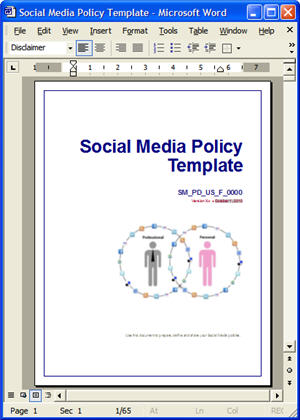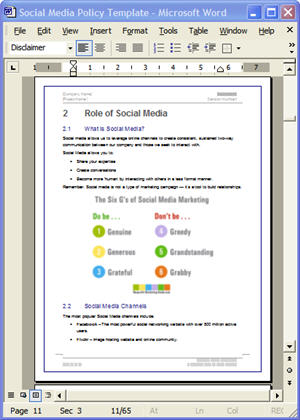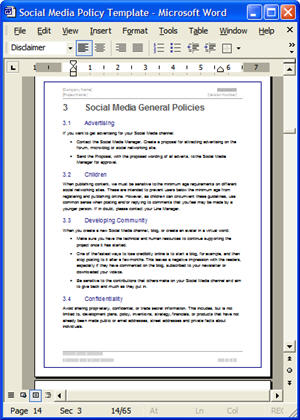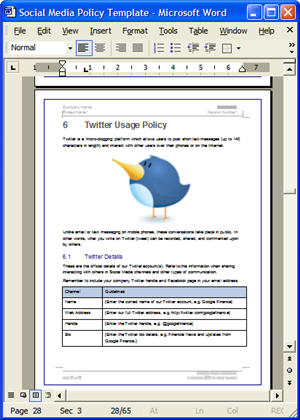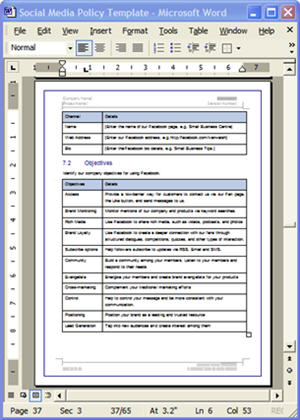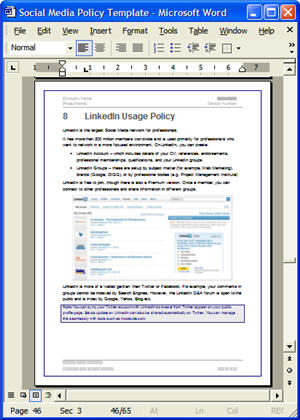Social Media Policy Templates (MS Word)
Download these MS Word Social Media Policy Templates and get a Master Social Media Policy Document (64 pages) and 9 Individual Policy templates. You can use these templates to create formal policy documents for your employees’ usage of Facebook, Twitter, LinkedIn, Blogs and more.
The templates are created in Microsoft Word (.doc) and can be easily modified to suit your requirements.
Social Media Policy Templates: Benefits
This template pack includes:
- Social Media Policy Template (64 pages) Use this template to define your Goals, General Policies, Confidentiality, Disclosures, Legal Issues, Intellectual Property, Brand Guidelines and more.
- Twitter Usage Policy – outline how employees may use Twitter to share, interact and communicate professionally.
- Facebook Usage Policy – show staff how to be an Ambassador for your business on Facebook Fan pages.
- LinkedIn Usage Policy – series of guidelines for using this professional network site and using LinkedIn groups
- Company Blogging Policy – guidelines for employees writing on corporate blogs; how to respond to comments, queries, feedback, and press enquiries.
- Personal Blogging Policy – use this to help employees understand their obligations when using personal blogs.
- Social Media Risk Management Policy – guidelines to reduce risk for employees and managers using Social Media sites.
- Brand Usage Policy – use this to ensure that your brand is used consistently across all social media network sites.
- Code Of Conduct – extensive list of Do’s and Don’ts when using social media network sites.
Note: the Individual policy documents are based on material in the Master Policy document.
Social Media Policy Templates: Table of Contents
The Social Media Policy Template (MS Word, 64 pages) contains the following chapters. The other policy documents are listed below.
1 Introduction
1.1 Right to Modify
1.2 Effective Date
1.3 Goals
1.4 Purpose
1.5 Scope
1.6 Points of Contact
2 Role of Social Media
2.1 What is Social Media
2.2 Social Media Channels
2.3 Social Media Benefits
2.4 Social Media Officer’s Objectives
2.5 Line Manager’s Guidelines
3 Social Media General Policies
3.1 Advertising
3.2 Children
3.3 Developing Community
3.4 Confidentiality
3.5 Employee Code of Conduct
3.6 Disclosures
3.7 Tone
3.8 Legal Issues
3.9 Level of Engagement
3.10 Making Friends Online
3.11 Negative Comments
3.12 Press Inquiries
3.13 Teens
3.14 Third Party Employees
3.15 Trademarks and Intellectual Property
3.16 Getting Further Assistance
4 Social Media Do’s and Don’ts
4.1 Setting up Personal Spaces in Social Media Sites
4.2 Generic Disclaimer for Social Media Sites
4.3 Social Media Do’s
4.4 Social Media Don’ts
5 Brand Guideline Policy
6 Twitter Usage Policy
6.1 Twitter Details
6.2 Objectives
6.3 Tone of voice
6.4 Ownership
6.5 Content Guidelines
6.5.1 Content Types and Sources
6.5.2 Leveraging Content
6.5.3 Exclusive Content
6.6 Hashtags
6.7 Link shortening
6.8 Re-tweeting
6.8.1 Reactive re-tweeting
6.8.2 Proactive re-tweeting
6.8.3 Follow Back
6.9 Product-specific accounts
7 Facebook Usage Policy
7.1 Details
7.2 Objectives
7.3 Tone of voice
7.4 Ownership
7.5 How Facebook Works
7.6 How to Get More Facebook Fans
7.7 Content Guidelines
7.7.1 Content Types and Sources
7.7.2 Leveraging Content
7.7.3 Exclusive Content
7.8 Security
7.9 Tagging Content.
7.10 Creating Shortening
7.11 Re-tweeting
7.11.1 Proactive re-tweeting
8 LinkedIn Usage Policy
8.1 LinkedIn Details
8.2 Objectives
8.3 Tone of voice
8.4 Ownership
8.5 Content Guidelines
8.5.1 Content Types and Sources
8.5.2 Leveraging Content
8.5.3 Exclusive Content
9 Company Blogging Policy
9.1 Objectives
9.2 Tone
9.3 Ownership
9.4 Content Guidelines
9.4.1 Content Types and Sources
9.4.2 Leveraging Content
9.4.3 Exclusive Content
9.5 Hashtags
10 Personal Blogging Policy
10.1 Are There Limits On Blogging Accounts
10.2 What Should I Do With Name-Squatting
10.3 What Shortening Services To Use
10.4 Can I Create Twitter Accounts For Our Products
10.5 Is There A Specific Policy For Employee Blogs
10.6 Do I Need Approval Before Posting
10.7 Can I Disclose Confidential Information
10.8 How Should I Handle Personal Information On My Blog
10.9 Can I Write About Our Competitors
10.10 Can I Write About My Former Employer
10.11 Should I Disclose My Company Affiliation
10.12 Can I Share Technical Knowledge On My Blog
10.13 Can I Post Code Samples In My Blog
10.14 Do I Own My Blog Content
10.15 What Photos Can I use On My Blog
10.16 Can I Make Endorsements On Behalf Of The Company
10.17 How Do I Respond If Contacted By The Media
10.18 Do I Have To Use A Disclaimer On My Blog
10.19 What Happens To My Blog When I Leave
10.20 I Still Don’t Have An Answer To My Questions
11 Employee Code of Conduct Policy
12 Social Media Risks Management
11.1 Time Management
11.2 Communication Risks
11.3 Technical Risks
11.4 Negative Comments
11.5 Inappropriate Comments
Why Use a Social Media Policy?
You can use this Social Media Policy document to demonstrate that your company is committed to transparency and honesty in its communications with employees, partners and customers.
To ensure that this is realized across different Social Media sites, you can use this Social Media Policy document to help your employees understand their responsibilities when using Facebook, Twitter, and Blogging. The document also outlines employee responsibilities when blogging on their own personal sites and what information they may not post.
You can share this policy document with employees, contractors, agents, and other individuals engaged on behalf of Company, through an agency, partner, subsidiary, or franchise.
This Social Media Policy document helps you to:
- Establish a set of guidelines for all employees when using Social Media sites
- Ensure employees understand their legal responsibilities when interacting online
- Ensure employees understand their responsibilities when writing about our company, its products or services, on their personal blogs, Facebook pages and Twitter accounts
- Other goals include increase brand awareness, finding new markets, and positioning your company as a thought leader
Social Media Policy Templates: Screenshots
Here are screenshots of the templates. You can download these by clicking the Download Now link.
Social Media Policy Templates: Content & Format
| Social Media Policy Template – MS Word 64 Pages | |
| Social Media Guidelines – MS Word 7 Pages | |
| Brand Usage Policy – MS Word 2 Pages | |
| Twitter Usage Policy – MS Word 21 Pages | |
| Facebook Usage Policy – MS Word 22 Pages | |
| LinkedIn Usage Policy – MS Word 19 Pages | |
| Company Blogging Policy – MS Word 18 Pages | |
| Personal Blogging Policy – MS Word 15 Pages | |
| Code Of Conduct Policy – MS Word 1 Pages | |
| Social Media Risk Management – MS Word 3 Pages |
Product Specifications
File Format: The templates are in Microsoft Word and Excel format.
File Size: The Download file is 2 MBs.
Opening the Files: You don’t need any special software to unzip the files. To unzip the files, right click on it, then select Extract, and save it to your computer.
Getting Started: Depending on your MS Office settings, the files may say Read Only when you open them. If this occurs, click File, Save As and save the files. There are no security settings on any of the files.
Images: All of the images in the templates are copyright free.

